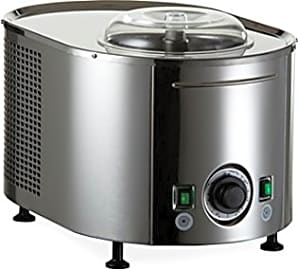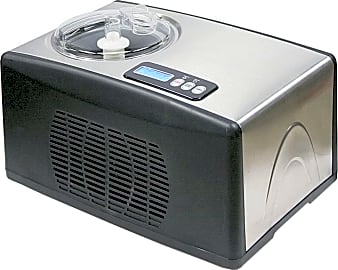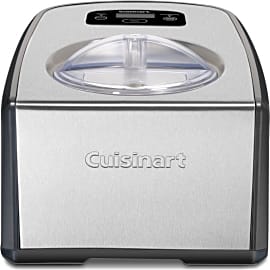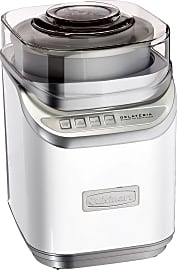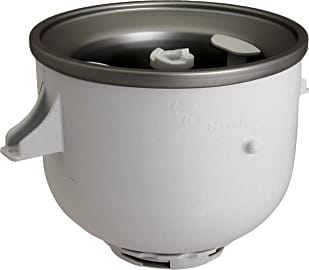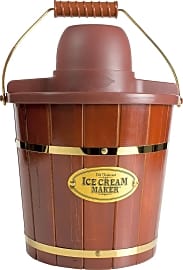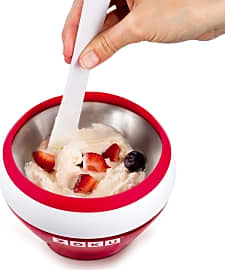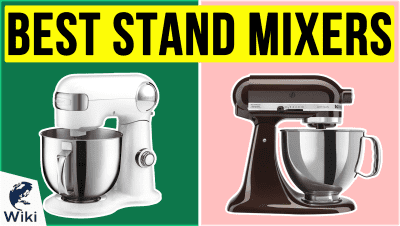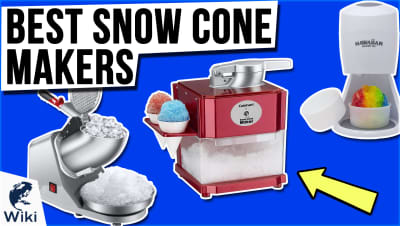The 10 Best Ice Cream Makers

This wiki has been updated 43 times since it was first published in March of 2015. Whether your favorite flavor is vanilla, chocolate, strawberry, or Neapolitan, these ice cream makers can have you mixing up frozen treats at home in no time. These handy machines can produce anything from decadent gelato to vegan sorbet to low-fat frozen yogurt, and allow you to ensure your family doesn't have to put up with any of the artificial ingredients often found in store-bought varieties. When users buy our independently chosen editorial picks, we may earn commissions to help fund the Wiki.
Editor's Notes
February 10, 2021:
We replaced the Whynter ICM-200LS with the Whynter ICM-201SB, which has the same 2-quart capacity but a smaller footprint due to its upright design, so it takes up less space on a counter. We removed the Hamilton Beach 68330N due to durability concerns and the Oster 4-Quart due to availability issues.
New to the list, the Yonanas Classic isn't designed for traditional ice cream, but can be used to make a healthier, fruit-based alternative. The Zoku Compact is also a good choice for health-conscious dessert lovers, as it makes you work for your ice cream by stirring it by hand, rather than utilizing a motor. It also produces a small amount, which can be helpful for portion control.
Homemade ice cream is great because you get to customize the flavor and consistency, and it's helpful for those with dietary restrictions who want to avoid common ingredients in commercial desserts. However, you have to be careful and make sure you're aware of the risks involved with certain ingredients. Eggs in particular should be treated with caution. According to the FDA, homemade ice cream causes several salmonella outbreaks every year. In order to avoid this, the administration recommends "substituting a pasteurized egg product, egg substitute, or pasteurized shell eggs for the raw eggs in your favorite recipe." You can also heat your eggs to an internal temperature of 160 degrees Fahrenheit and then let them cool before using them. Of course, there are a number of ice cream, fro-yo, and sorbet recipes out there that are completely egg-free to begin with, so if you want to play it safe you can always choose one of them.
December 12, 2019:
If you’ve already got a KitchenAid stand mixer, why bother buying an entire motorized ice cream maker when you can just use a convenient attachment designed for the mixer? That’s exactly what you can do with the KitchenAid KICA0WH, which comes with the 2-quart attachment bowl, a rotating “dasher” paddle that inserts into your mixer, and the drive assembly. It will make use of your mixer’s powerful technology, which actually spins the paddle faster than would the highest setting on many standalone, motorized models. The result is the fluffiest ice cream around. And, the compact bowl is easy to wash and store in any cabinet. It’s an affordable alternative to the others and takes up less space, to boot. One caveat is you do have to pre-freeze the bowl before using it.
The Breville Smart Scoop steals the top spot in this update, as a high-tech model equipped with a clear LCD and surrounding illuminated buttons that give you plenty of control over the speed, 12 hardness settings, and the type of dessert you’re making (ice cream, frozen yogurt, gelato, or sorbet). It can be set to keep your frozen flavors at the perfect temperature for up to three hours once it’s done making them. It’s definitely quite an investment, but one that will last for many years of family enjoyment.
Another top choice is the Musso Lello, which is known for producing batches of smooth, icy cold goodness. It too is quite an investment, featuring a powerful motor and a stainless steel build, but will also give you years’ worth of use which makes it great for households with frequent ice cream eaters. For a much more budget-friendly model, check out the low-maintenance Hamilton Beach 68330N, which just requires you to add your ingredients, lock it shut, and press a button.
Special Honors
Crathco Karma Gravity This 2.5-gallon soft serve machine is great for restaurant owners, as it provides a high output with a small footprint. It’s known for being one of the smallest and quietest around – yet it can still produce almost 19 pounds of ice cream or other frozen products per hour. That comes out to 150 cones, which is likely enough to cover your busy weekend afternoon rush. You can choose from among three product consistency levels, and a minimum-level warning light will alert you when your ice cream is running low. It offers an LED lighting system and customizable dispensing cover. Required are a 115-volt electrical connection and a 1400-watt output. webstaurantstore.com
A History of the Ice Cream Socio-Economic Revolution
These immigrants began an ice cream revolution for the masses, on cheap wooden wagons with large metal cranks rumbling down New York's cobblestone streets.
The history of ice cream has always been about economics and class. Back when Roman Emperor Nero ordered his servants to retrieve straw-wrapped bundles of snow from the mountains and mix it with fruit and honey, he was continuing a royal tradition. Even today, kids all over the world are still into Snow Shakes.
Before Nero, monarchs from Japan, Turkey, India, and Arabia were also known to make icy syrup deserts for their royal banquets. For most of human history, ice cream has been a delicacy reserved for the elite. Who else could obtain and preserve such an ephemeral commodity long enough to serve and enjoy it?
Fast-forward to the ice industrial revolution: By the early part of the 19th century, ice was available for delivery at affordable prices in many parts of the world. Ice cream became de rigueur at the garden parties of the well-to-do, consumed from porcelain cups with tiny silver spoons; of course, it was still not exactly an available pleasure for the commonfolk.
As these jobless migrants emigrated to the United States, they used the culinary prowess from their homeland to show Americans good food: the most important here being ice cream. These immigrants began an ice cream revolution for the masses, on cheap wooden wagons with large metal cranks rumbling down New York's cobblestone streets.
By the 1860s, there were thousands of wagons with customers lining up for this delicacy, rich and poor alike. Finally, the great ethnic and economic diversity that was (and is) America could come together in a common indulgence, or, as Ralph Waldo Emerson saw it, in materialistic gluttony.
Nowadays, we're left with the unappetizing choice between mass-produced products of questionable nutritional value, and the 100 percent organic, gluten-free, cruelty-free, locally-sourced, fair-traded boutique, ice cream of the fashionable downtown and hipster districts.
The time has come to reclaim our ice cream history, to make ice cream on our own terms again, a revolution that a home ice cream maker can easily enable.
The Ins and Outs of Ice Cream Makers
Ice cream makers work much like cement trucks: they constantly stir the mixture to prevent it from hardening to a solid. In the case of ice cream makers, they're in constant motion to prevent unwanted ice-crystal formations.
How exactly does an ice cream maker work? Though much has evolved from the hand-cranked bucket of the late 19th century, it still relies on the same essentials: ice, cream, and circular motion. The mixture has to remain cool during the cooling process and has to constantly be in motion as mentioned above. This is why compressor models stay cool during operation, and freeze-bowl models must be pre-frozen. While in motion, the air is incorporated into the churning mixture to give it that beautiful creamy texture we all know and love.
Ice cream makers work much like cement trucks: they constantly stir the mixture to prevent it from hardening to a solid.
As for the actual machine, along with all those widgets mentioned earlier, there are generally three major components to each unit: the external drum, the central churn, and the container. These are fancy words for the hole in which you place the container, the part that mixes everything together, and the container bowl where all ingredients are placed. Some makers have external motors that also rotate the canister, though these are typically commercial-grade.
The method above may be consistent from one machine to another, but not all devices are created equal. To understand which model you need, it's best to ask yourself a few questions.
Is this intended as an activity for friends and kids? If so, the traditional salt-and-ice hand-crank machine is fun, but takes a lot of work to make sure there is a continuous supply of ice and salt. That's where the kids come in. Good thing child labor laws do not apply here.
Do you know when you will need the ice cream? If you're on top of the ball and know when you'll need ice cream ahead of the allotted time, a freeze bowl will suffice. You'll save money, and will be able to pre-freeze your container ahead of time. If you're the type of person who's always late for appointments, you'll want to splurge on a compressor model, where you'll be able to satisfy the urge in under half an hour.
As for which ingredients to use, that's completely up to you. However, for the diet-conscious consumer, remember that low-fat dairies do not produce the same results as whole-fats would; mostly in the creamy texture department. We're sure there's some science behind that, but for now, just take our word. Think of it this way, the top-quality ice cream at the grocery store, which never seems to go on sale, has at least 12 percent milkfat (no wonder it tastes so decadent).
How Women Rule the World, One Ice Cream Maker at a Time
Prior to ice cream makers, there was the spoon-stir method. Yes, it is as horrible and time-consuming as it sounds.
Nancy Johnson from Philadelphia patented the first hand-cranked ice cream freezer in the U.S., back in 1843. This first model took about 45 minutes of turning to complete a batch; it sounds like a lot to us now, but it was much easier than the spoon-stir method previously mentioned.
By the 1880s, smaller home ice cream makers proliferated, though they still used the same concept as Nancy's original design.
Her idea not only simplified the ice cream making process, but it was truly revolutionary--for the first time in history, people could make ice cream in their own homes. Luckily too, at that time, rock salt was a commodity everyone could afford. Nancy ended up selling her patent to William Young, who named the machine after her: the Johnson Patent Ice-Cream Freezer.
In 1851, Jacob Fussel from Baltimore established the first large commercial ice cream plant. How did he come up with such an idea? In an attempt to save the surplus milk from his dairy farm before it went sour, he came up with the idea to turn it into mass-produced ice cream. In turn, this cold product became even more affordable for consumers, and eventually established ice cream parlors all over the country.
By the 1880s, smaller home ice cream makers proliferated, though they still used the same concept as Nancy's original design. They consisted of a metal inner pail with a paddle attached to a crank handle. This was placed inside a wooden bucket filled with a freezing mixture of ice and salt. The cream seeped from the outer bucket into the metal pail, where it was churned until frozen.
Today, we're more accustomed to electric models that require much less attention and produce more consistent results. They may not produce the same nostalgia as traditional cones, or the jingle of an ice cream truck, but they have been around for a long time, and the result is much more satisfying.



